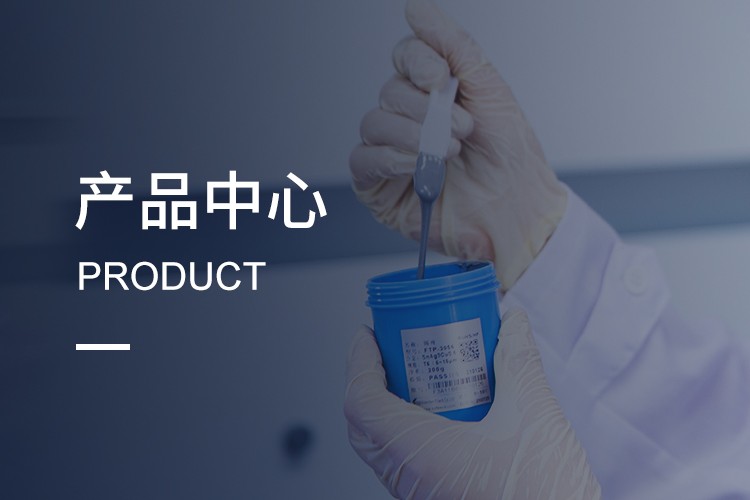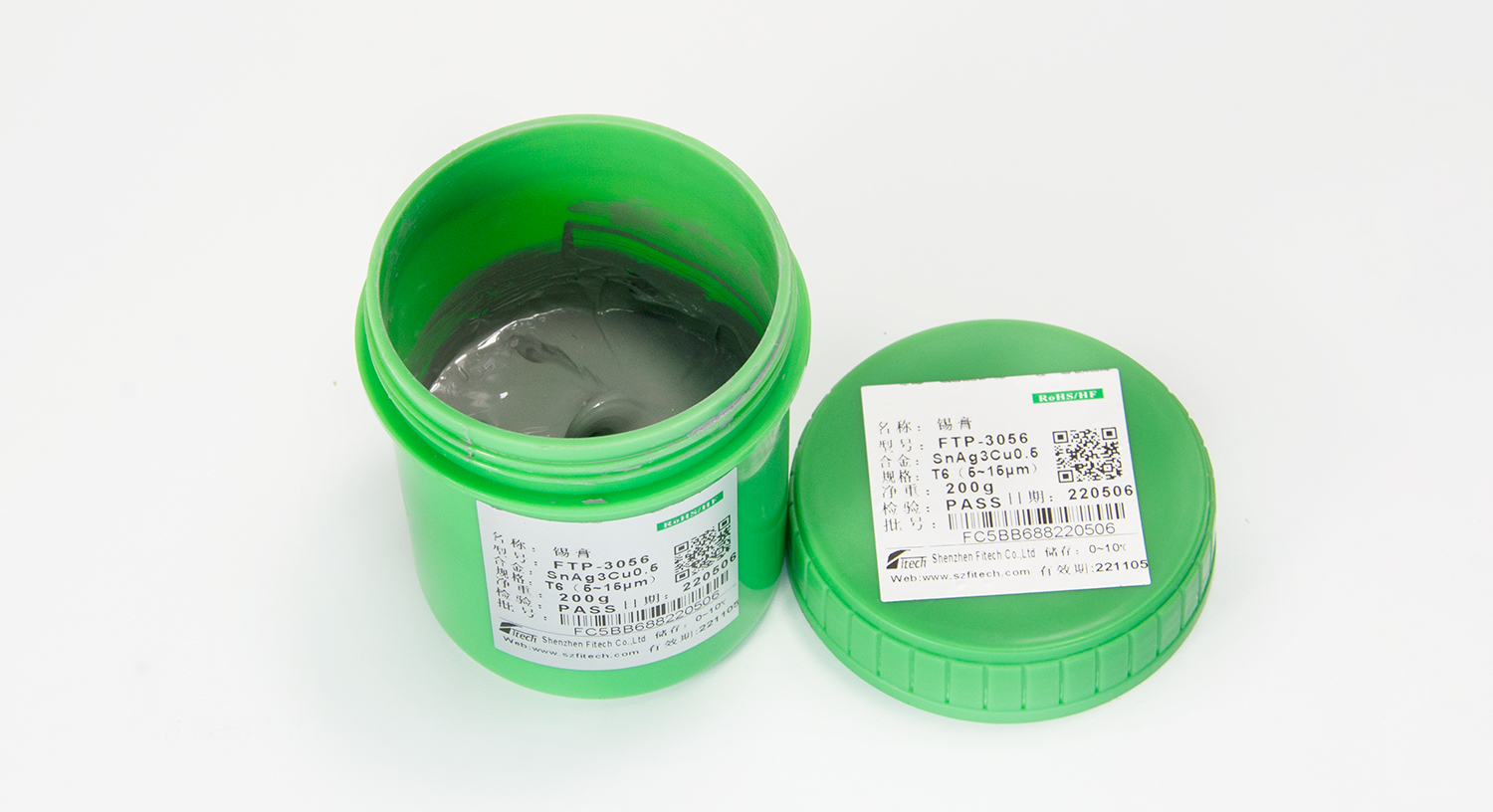
Printing solder paste is a kind of solder paste that is printed on the substrate pads through the stencil apertures. Printing solder paste is widely used in the SMT and semiconductor packaging processes.
Printing solder paste is the most prevalent kind of solder paste in electronic assembly. Extraordinary printing solder paste requires excellent solder release performance, long stencil life, superior anti-slump performance, and outstanding thixotropic performance.
The specific surface area of the solder alloy is large as ultra-fine solder pastes (T6 and above) have small particle sizes. A large surface area of the solder alloy leads to a great increase of contact area with the air, which makes it easier to be oxidized. With the progress of printing, the solder paste with inappropriate control of oxygen content will be continuously oxidized in the air, resulting in dramatic changes in viscosity and thixotropy, thus reducing the stability and reliability of the process.
One of the keys to controlling the quality of ultra-fine solder paste is to reasonably control the oxygen content of the ultra-fine solder powder in solder paste, thereby ensuring the process stability of the printing solder paste.
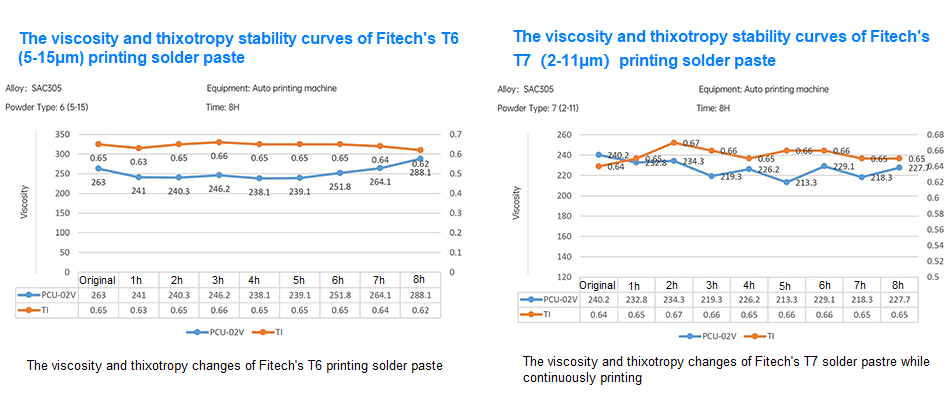
Features
FTP-125
FTP-0176
FWS-305P
FTP-574
FTP-305
FTP-170
FH-260P
FTP-901
Features of Ultra-Fine Printing Solder Paste
|
A. The particle size of ultra-fine printing solder powder is small;
B. The particle size distribution of ultra-fine printing solder paste is narrow, and the size of solder particles is more uniform;
C. Good consistency: when stencil printing with small apertures, the deposit of ultra-fine printing solder paste is uniform and stable, and the solder volume and height are easier to control;
D. The ultra-fine printing solder paste is suitable for applications with small pad-to-pad spacing, which enhances the soldering reliability and yield.
E.Overall, the ultra-fine printing solder paste is an advanced, efficient, and reliable solder, which is applicable to the production of electronic components with high requirements for packaging size.
|
The FTP-125 can refine the IMCs, which allows a better soldering strength, fewer residues, and excellent wettability. The SAC125 (SnAgCuNi) solder powder with excellent sphericity, uniform particle size, and low oxygen content is mixed with halogen-free flux to produce FTP-125 printing solder paste. The solder paste has a superior tackiness effect before soldering and less solvent volatilization during soldering. Moreover, the solder paste has excellent satellite solder ball inhibition, anti-slump, and residue reduction properties. FTP-125 is suitable for micro-bump ultra-fine-pitch soldering.
1. Wide window period for solder paste printing process;
2. Reduced soldering residues and excellent wettability;
3. FTP-125 can refine the IMCs, leading to superior aging performance;
4. FTP-125 has narrow particle size distribution, excellent solder release performance, and extraordinary anti-slump effect, which is ideal for ultra-fine-pitch soldering;
5. Excellent chemical activity, satellite solder ball elimination, and good wettability;
6. The operation is simple. Reflow furnaces, electric heating plates, ovens, and other heating devices can be used;
7. Good thixotropy, proper viscosity, superior stability, no stratification, and long working life.



Warming Method: The sealed solder paste should rewarm to room temperature naturally; Rewarm no more than twice.
Warming Time: Return to warm for 2 to 4 hours at room temperature. The actual time required to reach thermal equilibrium varies by vessel size.
Note: Do not open the bottle cap without sufficient rewarming or shorten the rewarming time by using heating equipment.
Operating Environment: The best operating temperature and humidity are 20-25°C and 40-60%RH, respectively. Reflow soldering in a nitrogen atmosphere is recommended.
FTP-0176 printing solder paste adopts SnCuX silver-free formulation, eliminating the impact of silver migration.SnCuX silver-free solder powder with excellent sphericity, uniform particle size, and low oxygen content is mixed with halogen-free flux to produce FTP-0176 series solder paste. The solder paste has a superior tackiness effect before soldering and less solvent volatilization during soldering. Moreover, the solder paste has excellent wettability, anti-slump, and residue reduction properties. FTP-0176 is suitable for micro-bump ultra-fine-pitch soldering.
1. Wide window period for printing process;
2. No silver migration effect and fewer residue generation;
3. FTP-0176 adopts ultra-fine solder powder formulation with narrow particle size distribution, which ensures stable solder paste release performance;
4. It has outstanding thixotropy and appropriate viscosity;
5. Excellent chemical activity, satellite solder ball elimination, and good wettability;
6. The operation is simple. Reflow furnaces, electric heating plates, ovens, and other heating devices can be used.



Warming Method: The sealed solder paste should rewarm to room temperature naturally; Rewarm no more than twice.
Warming Time: Return to warm for 2 to 3 hours at room temperature. The actual time required to reach thermal equilibrium varies by vessel size.
Note: Do not open the bottle cap without sufficient rewarming or shorten the rewarming time by using heating equipment.
Operating Environment: The best operating temperature and humidity are 20-25°C and 40-60%RH, respectively. Reflow soldering in a nitrogen atmosphere is recommended.
The main alloy of FWS-305P water-soluble solder paste is tin-silver-copper (SAC305). The water-soluble solder paste product is prepared by mixing T5, T6, T7, or T8 alloy powder with halogen-free environmental-protection flux.
1. The alloy has excellent sphericity, uniform particle size, and low oxygen content;
2. Outstanding halogen-free flux is used;
3. It has superior adhesion performance before soldering;
4. The solder paste has excellent viscosity stability and superior stencil life;
6. It is an ideal solder with extraordinary water cleaning performance for high-reliability micro-bump ultra-fine-pitch packaging.
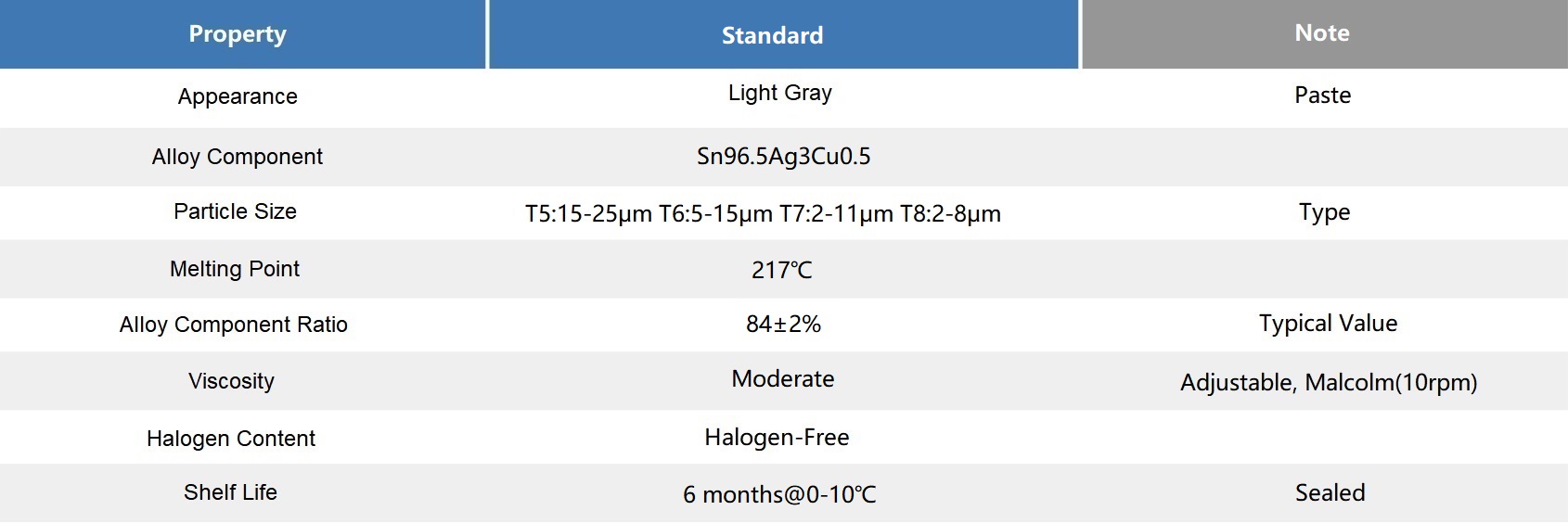

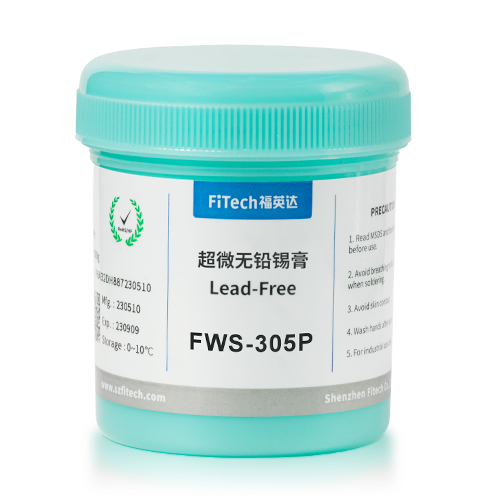
Warming Method: The sealed solder paste should rewarm to room temperature naturally; Rewarm no more than twice.
Warming Time: Return to warm for 2 to 3 hours at room temperature. The actual time required to reach thermal equilibrium varies by vessel size.
Note: Do not open the bottle cap without sufficient rewarming or shorten the rewarming time by using heating equipment.
Operating Environment: The best operating temperature and humidity are 20-25°C and 40-55%RH, respectively. Reflow soldering in a nitrogen atmosphere is recommended.
Cleaning Instruction: There is a small amount of residue around the pad after reflow, which should be cleaned with deionized water as soon as possible. The temperature of deionized water is between 25 and 40℃.
Fitech's tin-bismuth-silver alloy solder powder with excellent sphericity, uniform particle size, and low oxygen content is mixed with excellent zero-halogen flux to prepare FTP-574 series low-temperature solder paste. Solvent volatilizes very slightly during soldering. There is no solder ball formation and only a small amount of residue forms after soldering. Moreover, the product has outstanding wettability, and the solder joints generated are plump and bright. It is effective for low-temperature component mounting.


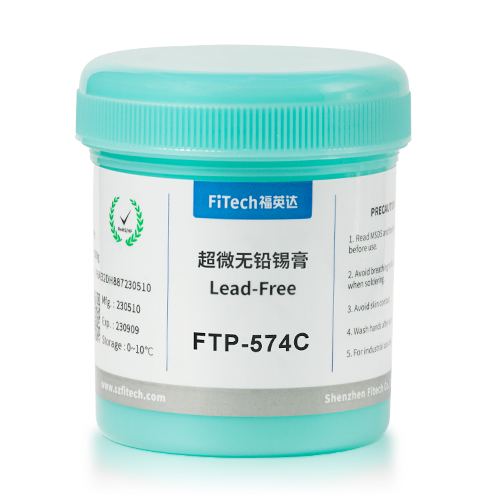
1. Warming Instruction: Solder paste needs to be refrigerated, and the preferred temperature is 0-10°C. When the solder paste is taken out from the cold box, its temperature is much lower than the room temperature. If the bottle cap is opened without rewarming, the water vapor in the air will easily condense and adhere to the solder paste. The high temperature exceeding 150°C during soldering increases vaporizatipn of water, which may cause the phenomenon of "exploding solder" to produce solder balls and even damage the components.
2. Warming Method: The sealed solder paste should rewarm to room temperature naturally; Rewarm no more than twice.
3. Warming Time: Return to warm for 2 to 3 hours at room temperature. The actual time required to reach thermal equilibrium varies by vessel size.
4. Note: Do not open the bottle cap without sufficient rewarming or shorten the rewarming by using heat equipment.
5. Operating Environment:The best operating temperature and humidity are 20-25°C and 40-50%RH, respectively. Reflow soldering in a nitrogen atmosphere is recommended.
6. Operating Time
① Continuous printing time: When adding solder paste continuously: 8 hours; In case of discontinuous addition of solder paste: 4 hours; ② Please add solder paste before the solder paste on the board is almost one third (rolling diameter: 10mm or less); ③ Please keep the solder paste on the plate within 3 hours; ④ If printing is interrupted for more than 30 minutes, please clean the stencil. ⑤ Dwell time after printing: After the solder paste is printed, the components should be mounted as soon as possible and the soldering should be completed when passing the oven to avoid drying out the surface of the solder paste due to long storage, which will affect the component mounting and soldering effects. Generally, the recommended dwell time of solder paste is no more than 4 hours, while the low temperature bismuth-containing solder paste does not exceed 2 hours. If the printing is interrupted for more than 30 minutes or is temporarily interrupted, the printing template needs to be cleaned. It can continue to work after 1-2 trial printing. The solder paste attached to narrow space of the opening (≤0.4mm) and the opening of the stencil will gradually dry, which will degenerate the adhesive ability.
Fitech produces SAC305 solder powder with excellent sphericity, uniform particle size, and low oxygen content, and it is mixed with halogen-free flux to prepare FTP-305 series solder paste. The solder paste has a superior adhesion effect before soldering. Solvent volatilizes very slightly during soldering. Moreover, FTP-305 has outstanding wettability, anti-slump, and residue reduction properties. There is no solder ball formation during soldering. The product is ideal for micro-bump ultra-fine-pitch packaging.
1. Before Curing:
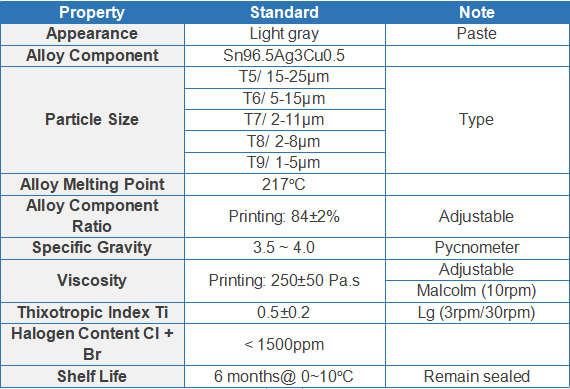
2. After Curing:


Warming Method: The sealed solder paste should rewarm to room temperature naturally; Rewarm no more than twice.
Warming Time: Rewarm 2 to 3 hours at room temperature. The actual time required to reach thermal equilibrium varies by vessel size.
Note: Do not open the bottle cap without sufficient rewarming or shorten the rewarming time by using heating equipment.
Operating Environment: The best operating temperature and humidity are 20-25°C and 40-50%RH, respectively. Reflow soldering in a nitrogen atmosphere is recommended.
Low-temperature FL170 alloy solder powder with excellent sphericity, uniform particle size, low oxygen content, and high strength are combined with zero-halogen flux to produce FTP-170 series low-temperature solder paste. Only a small amount of solvent volatilizes during the soldering process. There is no solder ball formation after soldering. In addition, FTP-170 has an excellent performance in residue minimization and wettability. The solder joints generated are strong, plump, and bright. The product is ideal for low-temperature soldering, especially for low-temperature component mounting.
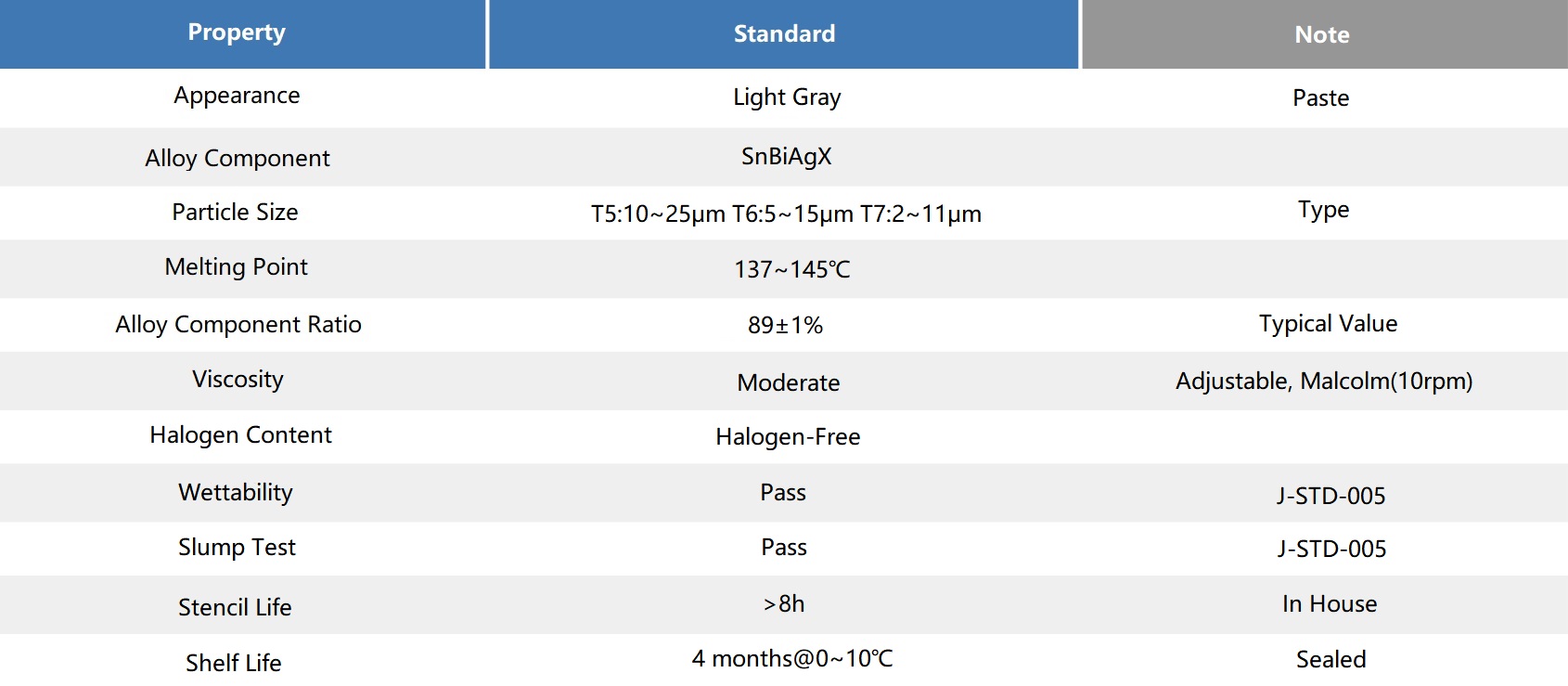


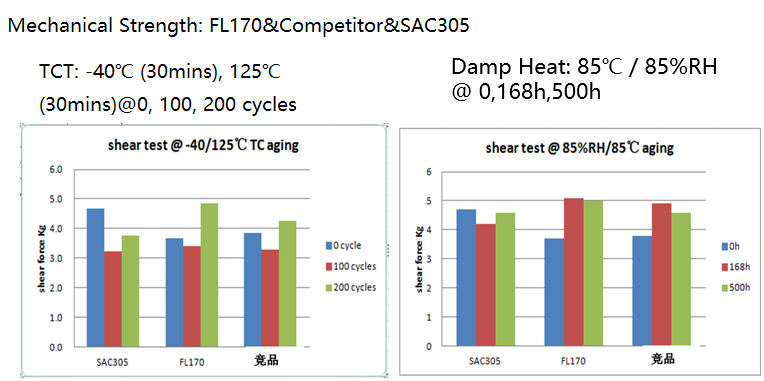
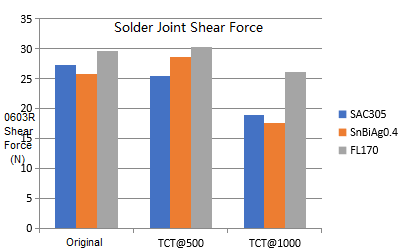
1. Warming Instruction: Solder paste needs to be refrigerated, and the preferred temperature is 0-10°C. When taking out the solder paste from the cold box, its temperature is much lower than the room temperature. If the bottle cap is opened without rewarming, the water vapor in the air will easily condense and adhere to the solder paste.The high temperature exceeding 150°C during soldering increases the vaporization of water, which may cause the phenomenon of "exploding solder" to produce solder balls and even damage the components.
2. Warming Method: The sealed solder paste should rewarm to room temperature naturally; Rewarm no more than twice.
3. Warming Time: Return to warm for 2 to 3 hours at room temperature. The actual time required to reach thermal equilibrium varies by vessel size.
4. Note: Do not open the bottle cap without sufficient rewarming or shorten the rewarming time by using heating equipment.
5. Operating Environment:The best operating temperature and humidity are 20-25°C and 40-60%RH, respectively. Reflow soldering in a nitrogen atmosphere is recommended.
6. Operating Time
① Continuous printing time: When adding solder paste continuously: 8 hours; In case of discontinuous addition of solder paste: 4 hours; ② Please add solder paste before the solder paste on the board is almost one third (rolling diameter: 10mm or less); ③ Please keep the solder paste on the plate within 3 hours; ④ If printing is interrupted for more than 30 minutes, please clean the stencil. ⑤ Dwell time after printing: After the solder paste is printed, the components should be mounted as soon as possible and the soldering should be completed when passing the oven to avoid drying out the surface of the solder paste due to long storage, which will affect the component mounting and soldering effects. Generally, the recommended dwell time of solder paste is no more than 4 hours, while the low temperature bismuth-containing solder paste does not exceed 2 hours. If the printing is interrupted for more than 30 minutes or is temporarily interrupted, the printing template needs to be cleaned. It can continue to work after 1-2 trial printing. The solder paste attached to narrow space of the opening (≤0.4mm) and the opening of the stencil will gradually dry, which will degenerate the adhesive ability.
FH260 solder powder with excellent sphericity, uniform particle size, and low oxygen content is combined with halogen-free flux to produce FH-260P series solder paste. It is a high-temperature lead-free product developed for secondary reflow of power semiconductor and microelectronic packaging. The alloy is synthesized based on bismuth elements by adding reinforced micro/nanoparticles, successfully replacing high-lead solder paste, and meeting RoHS environmental protection standards.


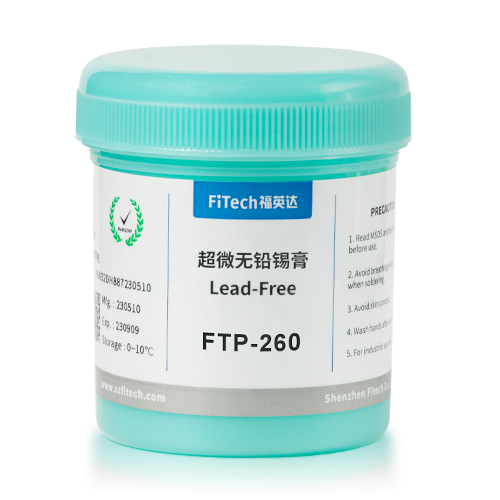
Warming Method: The sealed solder paste should rewarm to room temperature naturally; Rewarm no more than twice.
Warming Time: Rewarm 2 to 3 hours at room temperature. The actual time required to reach thermal equilibrium varies by vessel size.
Note: Do not open the bottle cap without sufficient rewarming or shorten the rewarming time by using heating equipment.
Operation Environment: The best operating temperature and humidity are 20-25°C and 40-60%RH, respectively. Reflow soldering in a nitrogen atmosphere is recommended.
SnSb10 alloy solder powder with excellent sphericity, uniform particle size, and low oxygen content is mixed with no-clean flux to produce FTP-901 series solder paste based on metallurgical method and chemical structure. FTP-901 has a superior adhesion effect before soldering. Solvent volatilizes very slightly during soldering. Moreover, FTP-901 has outstanding wettability, anti-slump, and residue reduction properties. It is developed to meet the marketing demand for heat-resistant microelectronic device assembly and precision soldering. The product has extraordinary heat resistance and heat dissipation abilities. It also improves soldering voiding and the strength and conductivity of intermetallic compounds.
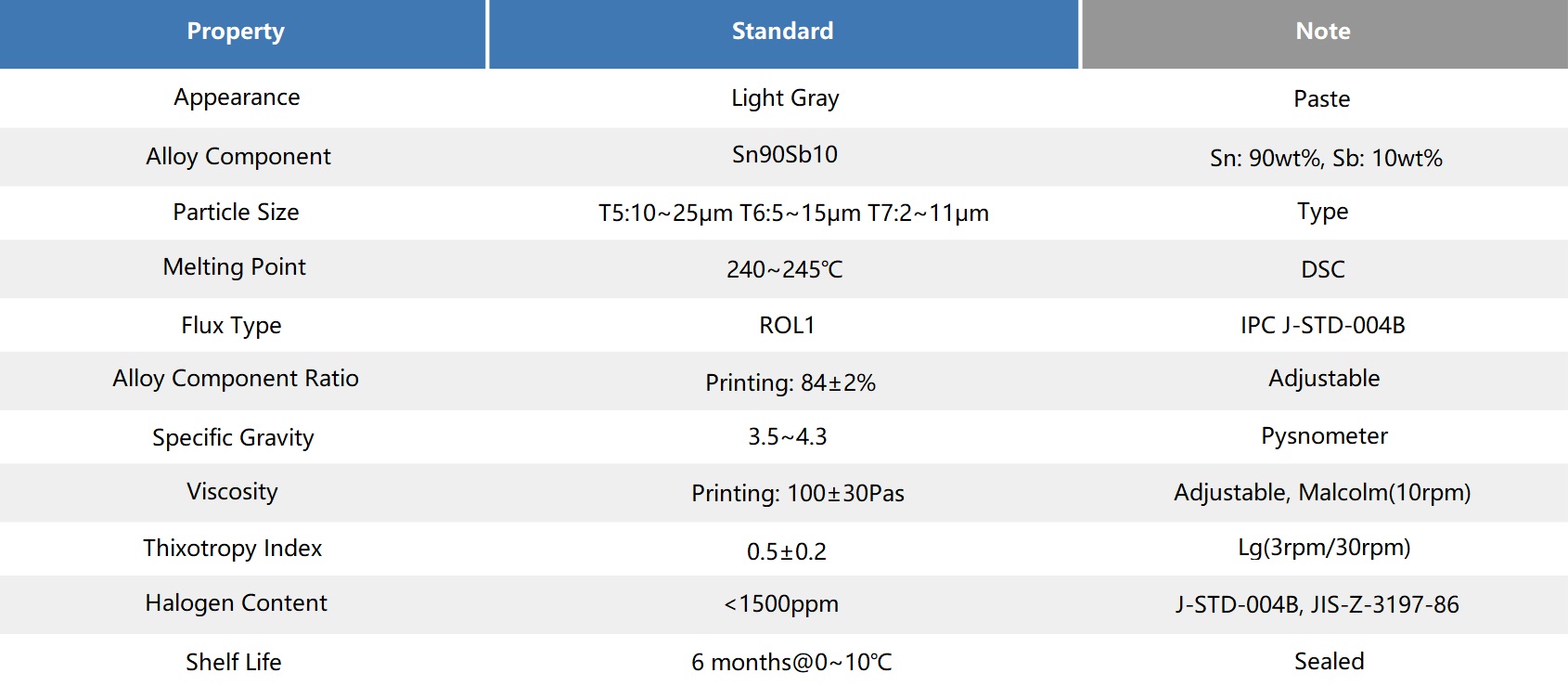
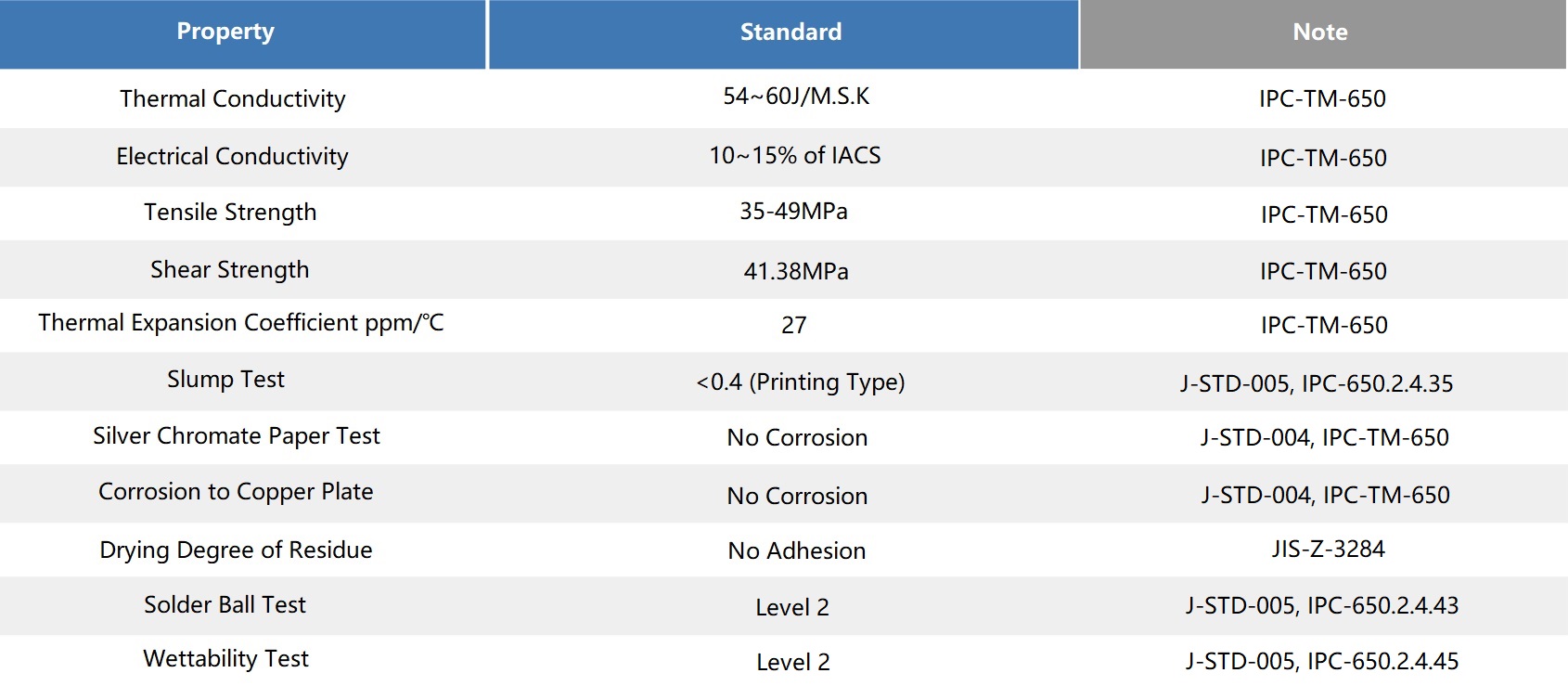
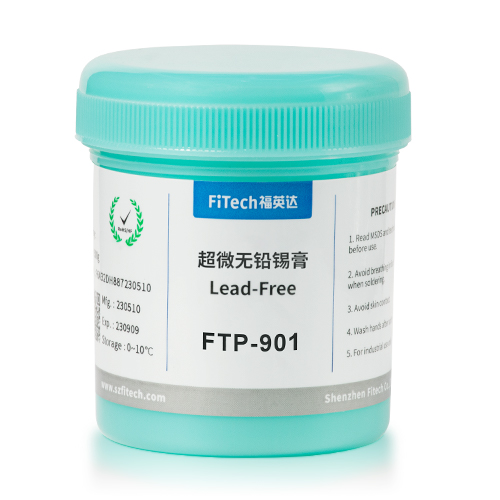
Warming Method: The sealed solder paste should rewarm to room temperature naturally; Rewarm no more than twice.
Warming Time: Return to warm for 2 to 3 hours at room temperature. The actual time required to reach thermal equilibrium varies by vessel size.
Note: Do not open the bottle cap without sufficient rewarming or shorten the rewarming time by using heating equipment.
Operating Environment: The best operating temperature and humidity are 20-25°C and 40-50%RH, respectively. Reflow soldering in a nitrogen atmosphere is recommended.









